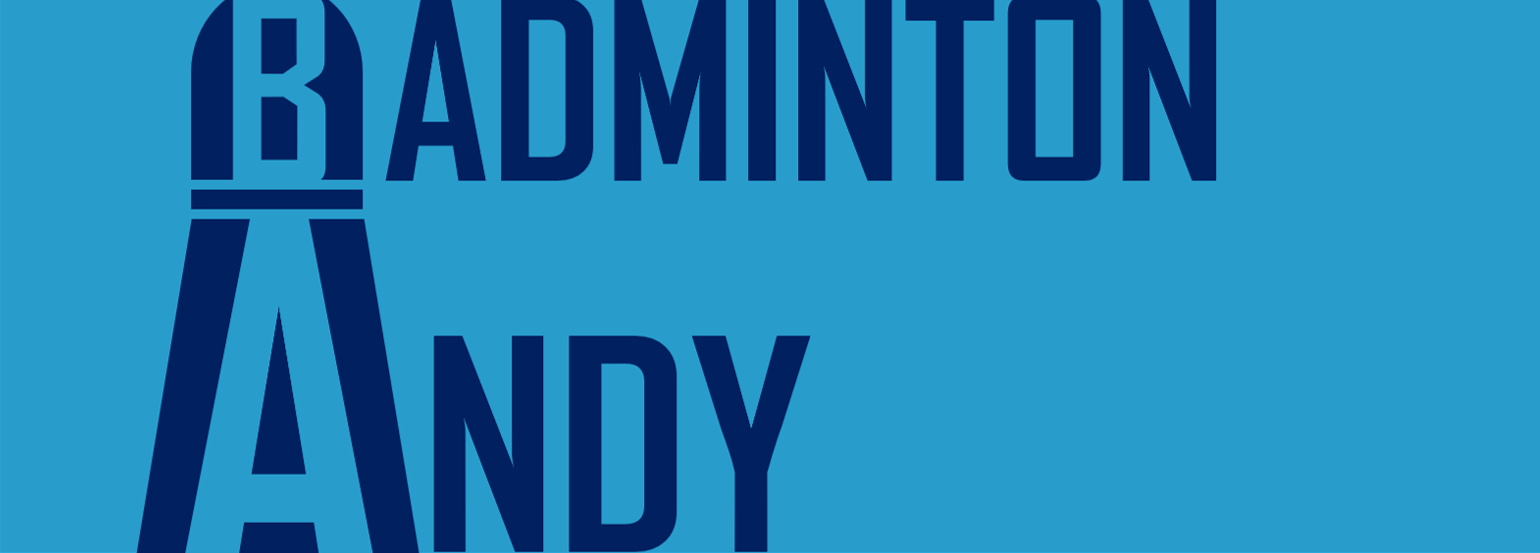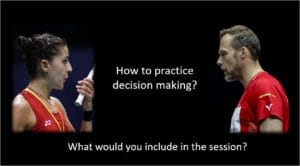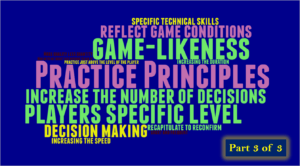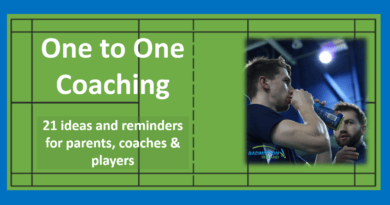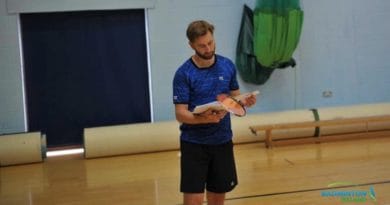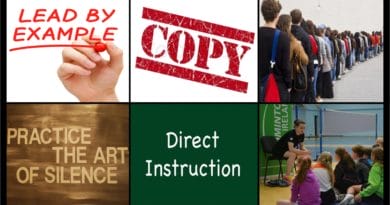The 8 pillars of effective Badminton Practice : Part 2 of 3
Badminton matches are often won by the players who make the best decisions
This article is based on work done by Roger Mills a professional badminton coach and my friend and mentor
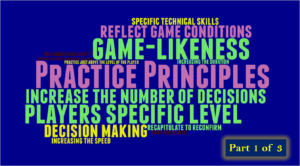 I hope that you enjoyed Part 1 and have found time to reflect on some of the suggestions to try in your badminton practice.
I hope that you enjoyed Part 1 and have found time to reflect on some of the suggestions to try in your badminton practice.
Has your think about badminton practice changed?
Did try out any of the suggestions in your weekly coaching?
When I was introduced to these badminton practice guidelines I found it easier to experiment during individual sessions with just one pupil. Yes, it was an experiment and it wasn’t always successful.
Often it was followed by a long telephone conversation with Roger trying to work out why some things worked and others didn’t. Remember, it’s good to talk!
I’m always here to help, email whenever you want contact@badmintonandy.com
In this post, I intend to try to explain why I think decision-making is one of the most underrated / under-practised skills. Look out for a future post called “The dangers of practising without decisions”.
This post will suggest when decision-making should be included in practice but will not go into as much depth as the article mentioned above. Point no. 5 is based on questions asked by Roger to me over 25 years ago. At that time I had no idea that the answer would affect the way I coached for the next 25 years.
How can you make practice harder and yet it still reflect a real game ?
– – – – – – – – – – – – – – – – – –
Part 1
1. Set the practice at the players specific level
2. Practice must be game-like:- reflect game conditions as closely as possible
Part2
3. Practice with decision making, when a player’s specific technical skills allow
4. Always be prepared to recap a previous practice to reconfirm a previously learnt skill
Part 3
6. To motivate a player in practice set the level of the practice just above the level of the player
7. A man with no target has nothing to aim at (Confucius)
8. Keep practice situations short and frequent. More quality less quantity
– – – – – – – – – – – – – – – –
3 Practice with decision making, when a player’s specific technical skills allow
When learning new skills it is often necessary to limit the number of decisions to be made by the learner.
This allows the player to concentrate on one or two details and not be ‘swamped’ with too much information (stimulus), this is easy to do without knowing. However, there is a danger to using badminton practice that does not contain decisions, especially if they form the majority of a players experiences.
Reducing the amount of decision making can lead to development, but will the player be ready for a competition when faced with an opponent who is trying to outwit (beat) them? The balance within badminton practice can be tough for the coach to control.
Competition requires players to be prepared to make choices and to respond to rapidly changing conditions.
Practice situations must reflect this
Coaches
The problem for the coach is when to introduce decision making.
I suggest that it should generally be earlier than you think, take a risk and hope. Coaching and practice is not a precise science. Hope, plus experimentation should not be feared by coaches. The more you gain experience the more your ‘hopeful’ decisions turn out to be nearly correct. Look out for a future post on “Hopeful Coaching”.
Once part of a skill is established then introduce an element of uncertainty or unpredictability
The following list will hopefully give you some effective suggestions. It’s your choice how many and to what degree they influence the practice. Be aware that as the number of decision-making opportunities increases, often the error rate initially increases.
Please don’t worry this will not be long-lasting.
I’ve found that it makes badminton practice fun and successful if you and the players are motivated and not looking for perfection. Please don’t be afraid of errors as long as they aren’t those technically limiting ones.
How would you use these suggestions?
– Give the players something to choose themselves within the practice. Try NOT to dictate a regimented outcome for all strokes
– Treat the players within the practice as ‘opponents’ rather than feeder and player (that means the feeder needs a racket)
– Create practices that ensure ‘opponents’ move only when they anticipate
– Try to ensure that one player doesn’t know exactly where the shuttle is going (a general idea is still ok)
– Create something that looks and emotionally feels like a game. How would you ‘feel’ in a game?
Dangers
Is it acceptable to question if badminton practice such as multi shuttle, 2 v 1, static (limited movement) or repetitive hitting helps develop those decision-making skills that are required to be successful in competition?
If you think that it is something to be discussed within coaching forums, by coach educators and by individual coaches, thank you! You need an opinion on how much non-decision-making practice you will do with your players.
I am sure that there are arguments for using these practices and I would agree with many of them.
However, is their use to create ‘thinking and creative winning players’ or some other skill required as a player? Consider how much decision-making there is in this in the type of work you set.
Please balance your use of practices that do not include ‘real’ game decisions.
The test for the coach is to initially limit the number of decisions and therefore the number of required responses by the player. As the player develops in the specific skill then increase the difficulty and complexity of the decisions required.
Eventually, the practice should resemble a real game with total uncertainty for both players
If you want to read more about including decision-making into practice read this post
– – – – – – – – – – – – – – – –
4 Always be prepared to recap a previous practice to reconfirm a previously learnt skill
This may sound like common sense. However, ask yourself the question; “how often do I include something in a session that was practised in the last one?” Not with the aim of just repeating it, but with the aim of subtly checking development and understanding.
I have two suggestions, ask a question to the player/group or set a task and observe. Which do you think is most effective?
Ask a question
This could be asked before the warm-up starts.
Ask the player to recap (remember) what they worked on last time and to think about this while warming up. Request practical feedback from them and remember the answers don’t have to be exactly correct or in specific detail. They are players in front of you, not Coaches 🙂
.. “Can you remember what we did, please show me”
.. “How did that make you feel”
.. “What happened as the session progressed”
Please read the questions again. How many required a list of technical elements?
I’ve found it’s often better if the questions are general and require players to describe their feelings and reactions or suddenly start to show you on the court what they did. I’d rather they thought about the successes or struggles rather than a list of points that would pass a BWF Level 1 Coach award.
I am not sure what to advise you if the player runs to their bag and starts to read from their diary, repeating your coaching programme and notes! I would rather they didn’t.

Observe without talking
Another method is to try a practical review, but only known to you the coach.
New skills are often based on elements of previously learnt ones. Therefore some form of practical review is essential. When learning a new skill it is a good idea to first practice a previously acquired one which contains elements required for the new skill. This will make the best use of some of the already part established critical elements.
There is no need to explain this to your player. I would advise that you use the ‘success’ of the previous practice to help start the next.
Summary
Plan sessions with the aim of using an element of a skill from a previous session. Initially, repeat the previous practice. Check to see if the skill element is robust enough to use in the next practice.
Don’t explain to the player, just start the next development. You may be surprised at the results when you ‘Do’ rather than ‘Explain’
– – – – – – – – – – – – – – – –
5 Practice should be made harder not just by increasing the speed or the duration but by increasing the number of decisions
This is very similar to principle No.2, however, it is a common misconception that the only way to make a badminton practice harder is to make it faster or longer.
Coaches often only increase the speed of the feeding as in the case of multi-shuttle work. Or they increase the duration and create rallies in excess of those found in a competition.
Do you include any decision making in your practices to make it harder, or do you just rely on increasing speed and number of shuttles?
It may seem fun and ‘tough’ work,
but do they assist players in winning that match, especially at 17-18 against an intelligent opponent?
Studies have shown that the average singles rally across all age groups is between 5-7 strokes with 60% of all rallies finished before the 7th shot. Click here if you want to read that study.
Increasing the speed of the feed or the players’ movement may sometimes have a negative effect. If the speed is taken “beyond the game” then the player will no longer be performing game-like movements. I do however recommend that doubles practices are taken beyond game speed, especially in defensive practices.
Increasing the duration, especially in singles work, can be positive and negative.
Long rallies (above 15 strokes) certainly exist. However, the largest percentage is far below that number. Be aware that you may be training different tactics and mental approaches if a large part of the training requires players to perform in lengthy rallies or practices.
Once a skill can be performed at game speed, increasing the amount of decisions the player has to make will provide the most effective learning for a real game.
If you want to read more then look out for a future post .. 6 Ways to make a badminton practice tougher
There are however some skills and situations that can benefit from ‘beyond the game’ stress of speed and physicality. These will be addressed in later articles and are often found in doubles practices. They are not in the majority and as mentioned applied to specific situations.
Summary
In a game, neither player knows where the other player will hit the shuttle.
However both players are tying (we hope) to anticipate what may happen, try to affect the opponents choice of next stroke. All these actions happen in a real game, but not always in practice.
How can you develop and enhance these anticipatory and reaction skills? Do you agree that the speed and choice of decision is often what separates two equally physically and technically matched payers?
Increase the amount of decision making and the practice will immediately become ‘harder’ and hopfefully more effective
Which of the 3 points did you find most interesting or challenging?
In Part 3 we will explore when to introduce decision making and how to make badminton practice harder. I hope you will stay around and be prepared to comment and try out the suggestions.
– – – – – – – – – – – – – – – –
Is there anything that you’ve read that has helped or you disagree with then please send me an email.
If you are willing to offer a comment then you are very welcome. I’d love to hear your views
contact@badmintonandy.com
